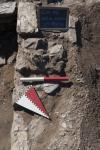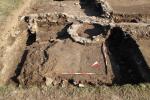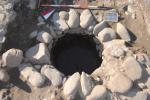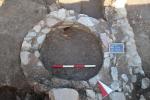Summary (English)
This was the second campaign of excavations in the quarter to the east of the southern segment of the cardus maximus in the urban centre of Luni. The excavations were extended to cover an area of 12 × 12 m.
The investigation continued of room 1 in the southern sector. It had an opus signinum floor that was slightly buckled/warped running from the west wall sloping down to the east. The southern part of the wall presented a make-up of very fine opus signinum covered by smoothed mortar. Both floors were cut by the construction of a well built of large cobblestones (fig. 1). The structure also cut a layer of accumulated material, datable to between the final decade of the 5th and the mid 6th centuries. The destruction layer relating to the wall dated to the mid 7th century A.D., when the room was finally abandoned.The continuation of a deep robber trench cutting the floor was identified in the northern sector. The stratigraphy relating to the floor make-up was visible in the trench, which was also characterised by the presence of large pieces of the floor that had collapsed into it. The trench was covered by a layer of greyish-black clay containing numerous finds (tile, pottery and metal fragments, bone), which dated it to between the 6th and 7th centuries A.D. This layer was the final accumulation above the trench fill, thus documenting the phase when the room was finally abandoned.
Room 2, which in the first phase was linked to the first by an opus signinum threshold that was later blocked (fig. 2), was excavated as far as its south wall. This room’s floor of vertically placed small stones bonded with abundant mortar also presented substantial warping up against its north wall.
In the northern part of the trench, the excavation of room 3 was completed (fig. 3). Square in plan, it was paved with marble grit and mortar and had a threshold in correspondence with the north-eastern perimeter wall. Grey glaze (Morel 2287 type plate) and cooking wares, found below the floor make-up in the room date the original construction to the first half of the 1st century B.C.
Later, at a moment generically attributed to the imperial period, a circular vat was built (diam. 1.3 m) with an opus signinum floor and a drain of terracotta pipes (fig. 4). The structure, positioned in the southern corner of the room, suggests that room 3 together with the open-air space adjacent to it had an artisanal function, which remains to be clarified. A layer of black clay containing ARS D (Hayes 61B2 and 91B) and eastern amphorae type LRA 4B2, date the abandonment of the structure to the central decades of the 6th century A.D.Robbing took place in the antique and modern periods that led to the complete removal of most of the room’s perimeter walls; the materials found in the related levels date the final abandonment of this sector of the excavation to the 7th century A.D.
- Paolo Sangriso – Università degli Studi di Pisa, Dipartimento di Civiltà e Forme del Sapere.
- Stefano Genovesi – Università degli Studi di Pisa, Dipartimento di Civiltà e Forme del Sapere
Director
- S. Menchelli- Università di Pisa Dipartimento di Civiltà e Forme del Sapere
Team
- A. Maccari
- R. Marcheschi- Università di Pisa Dipartimento di Civiltà e Forme del Sapere responsabile rilievo
Research Body
- Università di Pisa-Dipartimento di Civiltà e Forme del Sapere
Funding Body
- Università di Pisa- Dipartimento di Civiltà e Forme del Sapere






![Download [PDF]](/excavation/skins/fasti/images/results/download_sml.png)


